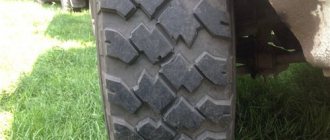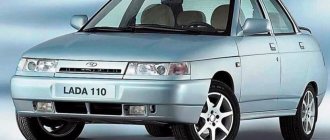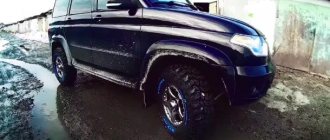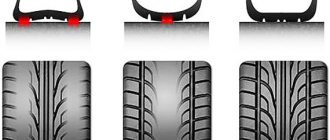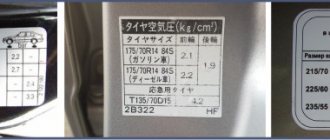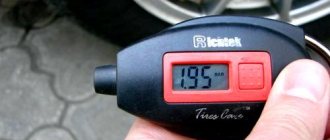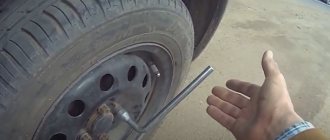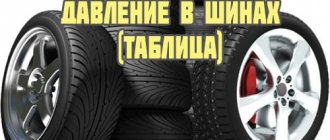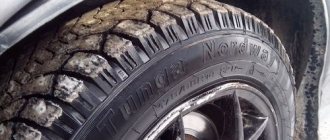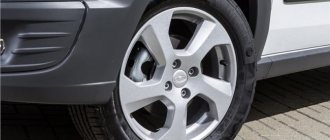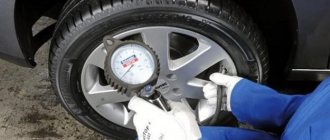One of the elements of the VAZ 2107 that ensures safe driving is car tires. The condition of the wheels is determined not only by their appearance (tread depth, balancing, surface integrity), but also by the air pressure in them. Compliance of this parameter with the standard allows you to extend the service life of not only tires, but also other elements of the car.
- Why is it important to check your tire pressure?
- Tread wear due to incorrect pressure
At low pressure
- For high blood pressure
- Video: tire pressure recommendations
- Seasonal change in tire pressure
Tire pressure in summer
- Tire pressure in winter
Video: how to check tire pressure
What determines tire inflation?
Indeed, the pressure indicator is not a constant value; its change is influenced by several factors, three of which are the most important.
The time of year and temperature changes must always be taken into account, so the driver must adjust the amount of air in the tires to suit the weather conditions.
The pressure in R16 tires in winter should always be higher than in summer. When heated, the air mass expands, and if the wheel is overinflated, it can explode. This rule also applies when choosing a driving speed, because the tire rubs against the asphalt and the temperature inside it becomes higher. So those who like to drive fast, and even in the hot season, need to remember their school physics lessons and monitor the tire pressure.
In winter, it is not recommended to senselessly reduce the pressure, as this can lead to disastrous results, but you also should not overinflate the tires. Winter tires are softer than summer tires, so the contact area between the tire and the road is larger. This allows you to drive your car more efficiently on slippery roads. When using all-season tires, sometimes you need to lower the ratings a little.
Tire pressure characteristics
The front and rear wheelsets are inflated differently, no matter whether it’s winter or summer outside. This rule is unshakable
Each car has wheels of a certain size. This information can be found in the vehicle's passport or on the nameplate located on the driver's door frame. The recommended pressure for such tires is also indicated there.
Operating conditions are very important. If there is a snowstorm or thaw outside, then the pressure in the R16 winter tires should be reduced slightly
This is also recommended when driving on sand or on uneven rural roads.
If there is a snowstorm or thaw outside, then the pressure in the R16 winter tires should be reduced slightly. It is recommended to do this also when driving on sand or on uneven rural roads.
What tire pressure should be in winter r19
We must not forget about the weight of the car when buying a new set of wheels, as well as its load capacity. Before you hit the road, you need to clarify what the tire pressure should be at the moment, under the given circumstances.
Dimensions, weight, load capacity
The vehicle has characteristics such as length, width, height. These indicators help the driver assess how much space the car occupies on the road. Length is the distance between the maximum protruding parts in front and behind. The width is determined by the boundaries of the side mirrors. Height is measured from the surface on which the vehicle is located to the highest point on the roof of the vehicle.
All this data is not difficult to find in the vehicle operating manual. Dimensions Niva 2131:
- length – 4240 mm;
- width – 1814 mm;
- height – 1640 mm.
dimensions
For Niva 2131, the outer minimum turning radius along the axis of the front wheel track is 6.45 m. Equally important indicators are weight (curb weight) and load capacity. The first is the total mass of a set of standard equipment, all necessary consumables (including engine oil, fuel, etc.), as well as the weight of the driver. Baggage and passengers are not included. The 5-door Lada Niva 4x4 weighs 1370 kg.
Table: VAZ 2107 tire pressure depending on size and time of year
| Wheel size | Tire pressure in summer (kgf/cm²) | Tire pressure in winter (kgf/cm²) | ||
| Front axle | Rear axle | Front axle | Rear axle | |
| 165/80R13 | 1,6 | 1,9 | 1,7 | 2,1 |
| 175/70R13 | 1,7 | 2,0 | 1,7 | 2,2 |
The table shows data for a car that is stored in a warm garage. Therefore, there is a difference between summer and winter pressure readings of 0.1–0.2 atmospheres, which makes it possible to compensate for the difference in indoor and outdoor temperatures.
The pressure in car tires depends both on the car itself and on the type of tires. This parameter is set from the factory and these values should be adhered to. In this way, you will be able to avoid possible troubles and protect yourself and other road users.
Source
Where to begin?
First, put on normal mud tires. At least 29″, no less. You can safely throw away the original tires from the factory, since you definitely won’t be able to drive them off-road. Yes, driving on asphalt with mud tires, to put it mildly, is not very popular - your ears are literally blocked from the noise (you can’t accelerate, alas), but as soon as you carry out such tuning of the Niva for off-road, you will be able to drive on quite serious roads with almost no problems. mud.
And everything would be fine, but this is where the manual work begins: the fact is that such wheels simply will not fit into standard arches, and therefore you will have to trim them. In principle, you can lift the car (or better yet, do both of these operations), but this is optional. If you decide to raise your “horse,” then the normal minimum is five centimeters. A lift kit will cost you about ten thousand.
Checking the tire pressure of a VAZ 2114: why is it needed and what should it be?
Every experienced driver knows firsthand how important a parameter such as tire pressure on a VAZ-2114 plays. Many car owners neglect the five-minute pressure measurement with a pressure gauge, in most cases making do with simply tapping the wheel with their foot.
Often, the poor condition of tires on the roads causes various unpleasant situations, including accidents. After all, the stability of a vehicle on the road depends on the pressure in the tires. Among other things, incorrect load distribution is often the reason for the increased “appetite” of the machine. How important is this parameter and what are the dangers of deviations from the norm?
How important is it to maintain normal blood pressure?
Ensuring optimal vehicle stability on the road is the main task of tires. The safety of the driver and passengers depends on the stability of the vehicle on the road surface. At the optimal pressure level at the point of contact of the tire with the road surface, the load is distributed evenly. Hence all the ensuing consequences - adequate consumption, uniform tire wear, good handling.
It is necessary to measure the parameter on cold tires in the garage just before leaving. You can measure tire pressure using a special device - a pressure gauge.
Car tire pressure table by tire brand
R13 tires are most often installed on the VAZ-2114 car. This is considered a kind of standard. Although, the car can be equipped with wheels with a radius from R13 to R16.
What pressure should be in winter tires r13 VAZ-2114
The task of every driver is to maintain an optimal pressure level. There is an opinion among car enthusiasts that the pressure should be different in the cold and warm seasons. There is some truth in this, but the difference should not be significant.
| 175/70 R13 | 1,9 |
| 175/65 R13 | 1,9 |
| 175/65 R14 | 2,0 |
| 185/60 R14 | 2,0 |
Tire pressure rises quickly in summer, so it is best to deflate excess air when the air temperature exceeds 25 degrees Celsius.
In winter, this figure drops faster. Such indicators are typical for a passenger car with an empty luggage compartment. In any case, the recommended value is indicated in the vehicle’s operating book. It is necessary to adhere to the standard certified by the manufacturer at any time of the year. In general, we can say that in winter the wheels should be inflated 0.2 atmospheres more than in summer.
What are the dangers of deviation from the norm?
In summer, due to high temperatures, the contact area between rubber and the road surface is significantly reduced. The pressure rises, and this is already an alarm bell for the driver. After all, rubber loses its elasticity and does not resist impact loads.
Plus, if you overdo it and overinflate the wheels, you can experience the following troubles while driving a car:
- Wear on the car's chassis increases, the ride becomes uncomfortable, and all the imperfections in the road surface are felt.
- The contact area of the tires with the road is reduced - the braking distance increases.
During high-speed driving, rubber may rupture, which in itself is not safe.
If, on the contrary, the tires are poorly inflated, the following consequences will emerge:
- Vehicle controllability will deteriorate significantly.
- The amount of fuel consumed will increase.
- On snowy or wet asphalt, the car will have a tendency to skid.
- The vehicle's power will noticeably decrease.
Experienced motorists can visually determine whether tire pressure is normal or not. Beginner car enthusiasts are recommended to take measurements at least once a week. It is enough to arm yourself with a pressure gauge, reset its readings to zero, connect the fitting of the device to the nipple and start applying pressure. Then record the readings of the instrument needle.
Standard tire pressure parameters r14
Useful video
You can get additional useful information on this issue from the video below:
Auto tips. Tire pressure
Conclusion
R13 wheels of a VAZ-2114 car are usually inflated to a level of 1.9 kgf/cm2. It is this indicator that contributes to the adequate behavior of the car on various road surfaces. The tire pressure in winter on a VAZ-2114 may be 0.2 atmospheres higher.
You should periodically take measurements and monitor the condition of your tires. After all, not only the service life of various vehicle components, the amount of gasoline consumption, but also the safety of road users depends on this.
Tire pressure table for different VAZ car models
The table below shows what the tire pressure should be for various VAZ car models. We provide an incomplete list, older types, like the VAZ-21099, and newer cars: VAZ-2110, 21111 and 21112.
Table of recommended tire pressure for VAZ cars
In winter, it is customary to lower the wheels a little, although it is officially stated that the degree of inflation does not depend on the season. However, lowered wheels provide the following advantages:
- better stability on slippery roads;
- smooth ride of the car;
- reducing braking distance and reducing the likelihood of an emergency.
BELOKAMENEZ › Blog › Tire pressure table for domestic VAZs
Model Wheel size (1111)VAZ OKA Front tire pressure (atm./psi) Rear tire pressure (atm./psi)135/80 R12 1.8/26 2.0/29VAZ 2101
165/80 R13 1.6/23 1.6/23VAZ 2102
165/80 R13 1.6/23 1.8/26VAZ 2103
165/80 R13 1.6/23 1.6/23VAZ 2103 175/70 R13 1.7/24 1.9/27VAZ 2104
165/80 R13 1.6/23 2.1/31VAZ 2104 175/70 R13 1.7/24 2.2/32VAZ 2105
165/80 R13 1.6/23 1.9/27VAZ 2105 175/70 R13 1.7/24 2.0/29VAZ 2106
165/80 R13 1.6/23 1.9/27VAZ 2106 165/70 R13 1.8/26 2.1/31VAZ 2106 175/70 R13 1.7/24 2.0/29VAZ 2106 185/60 R14 2 ,0/29 2.2/32VAZ 2106 190/55 R15 2.2/32 2.5/35VAZ 2107
165/80 R13 1.6/23 1.9/27VAZ 2107 175/70 R13 1.7/24 2.0/29VAZ 2107 185/60 R14 2.0/29 2.2/32VAZ 2107 190/55 R15 2 ,2/32 2.5/35Lada 2108/2109/2113/2114/2115
175/70 R13 1.9/27 1.9/27Lada 2108/2109/2113/2114/2115 175/65 R14 2.0/29 2.0/29Lada 2108/2109/2113/2114/2115 185/60 R14 2.0/29 2.0/29Lada 2108/2109/2113/2114/2115 190/55 R15 2.2/32 2.3/32Lada 2108/2109/2113/2114/2115 190/50 R15 2.2/ 32 2.4/35Lada 2108/2109/2113/2114/2115 190/45 R16 2.4/35 2.5/35Lada 2110/2111/2112
175/70 R13 1.9/27 1.9/27Lada 2110/2111/2112 175/65 R14 2.0/29 2.0/29Lada 2110/2111/2112 185/60 R14 2.0/29 2.0 /29Lada 2110/2111/2112 190/55 R15 2.2/32 2.3/32Lada 2110/2111/2112 190/50 R15 2.2/32 2.4/35Lada 2110/2111/2112 190/45 R16 2 ,4/35 2.5/35Lada Kalina (2118)
175/70 R13 1.9/27 1.9/27Lada Kalina (2118) 185/60 R14 1.9/27 1.9/27Lada Granta
175/70 R13 1.9/27 1.9/27Lada Granta 175/65 R14 2.0/29 2.0/29Lada Granta 185/60 R14 2.0/29 2.0/29Lada Granta 185/55 R15 2 ,1/31 2.2/32Lada Granta 190/50 R15 2.3/32 2.4/35Lada Granta 195/45 R16 2.4/35 2.5/35Lada Priora
175/70 R13 1.9/27 1.9/27Lada Priora 175/65 R14 2.0/29 2.0/29Lada Priora 185/60 R14 2.0/29 2.0/29Lada Priora 185/55 R15 2 ,1/31 2.2/32Lada Priora 190/50 R15 2.3/32 2.4/35Lada Niva (2121)
175/80 R16 2.1/31 1.9/27Lada Niva (2121) 185/75 R16 2.1/31 2.0/29Lada Vesta
185/65 R15 2.1/31 2.1/31Lada Vesta 195/55 R16 2.1/31 2.1/31Lada Largus
185/70 R14 2.4/35 2.6/37 Lada Largus 185/65 R15 2.4/35 2.6/37 Front tire pressure Rear tire pressure
Source
What non-standard sizes can be supplied?
Some vehicle owners practice installing wheels whose diameter differs from the standard one.
For example, mounting 16" wheels on vehicles whose arches are designed for 14" tires may cause:
- damage to the paintwork of the body;
- breakage of plastic fender liners;
- failure of mudguards.
After installation, non-standard wheels should not touch body elements or wheel arch liners. This will not only damage the plastic and paint. But it can cause other problems. Constant friction of the tire against the fender liner leads to rapid wear of the tread. Which requires premature tire replacement.
When choosing custom tires, keep the following points in mind:
- low-profile tires improve the handling of the vehicle - however, when driving on a road with poor-quality surfaces, the likelihood of damage to the suspension increases significantly;
- a larger profile may simply not fit in the arch and damage the car body;
- non-standard profile height requires adjustment and adjustment of the speedometer - otherwise the data it displays will be incorrect.
To install wheels of larger diameter, in some cases it will be necessary to roll out the wheel arches with a special roller. It will allow the openings to be enlarged, and the new wheel will no longer wear off the tread on the plastic of the fender liner.
Features, regulatory values, risks
Most car owners perceive wheel pressure as a certain constant value that needs to be maintained from time to time. Moreover, if any person interested in the topic thinks about it, he will be able to list the main functions assigned to tires:
- maintaining balance and balance of a passenger vehicle;
- passive and active safety while driving;
- ease of riding;
- reduced tread wear.
How much attention the driver pays to his tires can be judged by the tread, which wears out in a characteristic way. Based on wear, you can identify the main problems that are typical for a passenger car in motion.
But treads are only a reflection of the problems that the car experiences if the requirements are not met. The main risks of insufficient attention to these aspects are related to safety. In fact, by ignorance or oversight, by letting this problem take its course, you expose yourself and your loved ones to a significant risk of an accident.
How safety decreases when changing tire parameters
The nature and measures to reduce road safety are well illustrated by the table, which reflects changes in the nature of the passive safety of a passenger car.
Tire pressure measurement
Table 1. Effect of tire pressure on safety and wear resistance:
| Changing the pumping indicator | Nature of influence |
| Normal | Vehicle safety and controllability Normal fuel consumption |
| — 0.5 bar | An increase in tread wear by 20%, the possible mileage is approximately reduced by 8 thousand km. |
| — 1 bar | Dangerous driving parameters, additional fuel consumption. |
| — 1.5 bar | The car may lose control of the road |
| — 2 bars | Braking distance on wet asphalt increases to 11 m. |
Note! A wheel that has been used in a poorly inflated condition may explode when the parameters are restored, and this can happen right on the road. By the nature of wear, you can determine whether increased or decreased parameters usually occur on your model
This is well illustrated in the photo
By the nature of wear, you can determine whether increased or decreased parameters usually occur on your model. This is well illustrated in the photo.
Cardan lubrication Niva VAZ 21213, 21214, 2131 Lada 4×4
| How often should the driveshaft be lubricated?—According to the regulations, the driveshaft needs to be lubricated every 10 thousand km. How to lubricate the cardan? - Spline connection of the front driveshaft - with Fiol-1, CV joints-4 grease (or imp. analogues) Bearings of cardan joint crosspieces - with Fiol-2U grease, No. 158 (or imp. analogues) (see also Liquids used and filling volumes) We lubricate the spline joint of the sliding yoke of the propeller shaft by pumping grease with a syringe through a grease nipple until the grease comes out from under the seal. |
Using a syringe with a narrow tip, lubricate the universal joint bearings through a grease nipple until the grease comes out from under all the seals. |
If there is no narrow tip, we syringe the cardan joint bearings on the dismantled cardan shaft (see here). |
On some vehicles manufactured since 2009 (with reinforced spline joints), to replenish or replace lubricant in the spline joint, disassembling the driveshaft is required in the following order.
1. Remove the driveshaft (see here)
2. Mark the relative positions of the shaft parts.
3. Slide the yoke out of the splined end of the shaft.
4. Apply lubricant to the shaft and fork splines.
5. Assemble the shaft taking into account the marks made during disassembly.
6. Install the shaft in reverse order.
Keep your tires inflated
When checking, you should take into account what external factors may affect the reliability of the measurements. These factors include ambient and tire temperature. The higher the temperature, the higher the pressure, and vice versa. Therefore, it is recommended to carry out a mandatory check when there are significant changes in temperature, for example before winter.
To check and adjust pressure, you must have the following instruments/equipment:
- Car pressure gauge;
- Compressor or pump.
Despite the fact that most automobile compressors have a built-in pressure gauge, the most accurate measurement result is obtained with a separate pressure gauge, since there are no extraneous forces during the measurement, such as compressor pressure. If, according to the measurement results, the pressure is below normal, it is pumped up using a compressor or pump; if it is higher, it is released by pressing the spool, or a special button on the pressure gauge (if available).
Incorrectly adjusted tire pressure on a VAZ 2107, in addition to threatening traffic safety, can lead to premature wear of the chassis or damage to the tires. As a result, repairs will cost hundreds of times more than timely control.
It is also important that the wheel size matches the design features of the machine. Sometimes, in pursuit of beauty, some car enthusiasts install wheels whose size exceeds the permissible size for a given model, and as a result, chassis elements fail
Review of the best summer and winter tires
A good solution is to get two sets of tires. For winter it is better to buy studded ones. A good option for the summer would be the Michelin Latitude Sport 3 model. It has good stability regardless of the quality of the road surface and allows you to easily overcome even heavy mud.
Nokian Hakka Black has a relatively high price. However, compared to others, it performs well in the long term. Even with intensive driving, it can easily “live” for more than 5 years.
General Altimax Sport is a relatively inexpensive option for use in the warm season. Even at high speed, this tire model is practically inaudible. Allows you to easily move at speeds up to 190 km/h.
FULDA KRISTALL MONTERO 3 is distinguished by its unusual appearance. The deep tread and the presence of a large number of longitudinal grooves allow you to move through puddles at high speed. Hydroplaning is excluded.
PREMIORRI SOLAZO is a tire that allows you to move even in difficult road conditions without any special problems. The low weight of the tire saves fuel.
The choice of winter tires needs to be taken much more seriously. If you have a limited budget, the KAMA 505 “Irbis” would be a good solution. The protector deteriorates relatively quickly. However, this point is fully justified by the low cost of the model. Positioned as all-season.
Nokian Hakkapelitta 8 is a modern tire for passenger cars. It differs from its analogues in its reliability and maneuverability.
Nordmaster tires have an original tread pattern and a number of other important advantages. The presence of studs allows the driver to feel confident on asphalt and ice.
A distinctive feature of the TungaMaster is the presence of continuous ribs in the design. They provide a rigid, but at the same time easy ride of the car.
Atmel CordiantPolar is a classic solution with excellent technical characteristics. A good solution for winter. Reliable and inexpensive tires.
Using recommended tires is the key to road safety.
It is important to monitor the condition of the tread and the level of pressure inside the wheels. This will avoid problems on the road and make the car easier to drive.
Source
Flagships of the winter line in the domestic market
Which brand of tires to choose for the winter is difficult to answer unambiguously, since the choice depends on many factors: the characteristics of the road surface in the region, weather conditions, financial capabilities and many others. The rating of winter tires can be based on popularity among motorists, positive reviews, price/quality. I’ll just give you some popular models from various companies.
Atmel CordiantPolar model, suitable for middle-class foreign cars and domestic classics. The tread of the product is equipped with deep grooves, which prevents the effect of aquaplaning and removes dirt and slush from the contact patch. The rubber composition includes natural and synthetic rubber, which ensures that it remains soft even at low temperatures, down to -50 degrees. The basic model does not include studs, but according to the manufacturer's standard, 128 studs can be installed.
Tunga Tunga (C-140)
The brand's models such as Tunga and TungaMaster are also of interest; the tread is equipped with a solid central rib, an original tread pattern and lamellas of various shapes that separate the tread blocks. The equipment and composition of the tire provide reliable grip on any type of surface and remain soft at low temperatures. The possibility of installing spikes is provided. Rubber is available in sizes R13 and R14.
Nordmaster tires are equipped with an original tread pattern, there are a large number of sipes, the basic model has studs. The specific composition of rubber makes it possible to maintain the softness of the product at low temperatures. The structural features allow you to maintain grip on any type of canvas. Wide elements of the shoulder areas are provided. The tread pattern is supplemented with two middle longitudinal ribs. The shape and direction of the tread pattern helps to improve the vehicle's performance in deep snow. Available in sizes R13, R14 to R15.
Optimal car tire pressure
The main task of car tires is to provide effective traction between the car and the road. With normal air pressure in the tire, the load in the contact patch of the wheel with the road is distributed evenly, due to which tire wear occurs evenly, the car handles well and fuel consumption is within normal limits.
There are three possible scenarios in which the tire pressure will not be optimal:
- Increased pressure (tires overinflated);
- Low pressure (tires underinflated);
- Different pressure in all wheels.
Check the tire pressure with a special tire pressure gauge. This should only be done on cold tires, that is, before leaving the parking lot or garage.
If deviations from the normal pressure are detected in any of the tires (see the table below for what pressure should be in the tires of your passenger car), such a wheel must either be inflated or excess air released from it - that is, the pressure must be adjusted to norm. In one of our articles, we already talked about which car compressor is best for inflating tires.
It is worth noting that the tire pressure in winter should be exactly the same as in summer. But due to the sharp temperature change, in winter, monitoring the air pressure in the wheels needs to be approached more responsibly.
It is better to inflate your tires outside. Also, do not forget to check the tire pressure when there are significant changes in ambient temperature, and if necessary, adjust it:
- if it gets cold outside, the pressure in the tires will decrease,
- and when it gets warmer, it will rise.
It should also be remembered that while the car is moving, the tires heat up, the air in them expands, and the pressure increases, and the handling and braking properties change.
Increased tire pressure
With increased tire pressure, the load at the point of contact of the wheel with the road acts to a greater extent on the central part of the tire tread, thereby causing uneven wear of the tire.
On overinflated wheels, the car brakes worse! This happens because if the tires are overinflated, the contact patch with the road decreases, which means the friction force that keeps the car from sliding decreases. At the same time, the braking distance increases noticeably.
In just twenty minutes of driving, taking turns as aggressively as possible, the pressure in the car’s tires can increase by 0.5 atmospheres. And on long trips at high speed, the pressure in the tires can increase to 4-5 atmospheres. And modern tires are designed for this.
But if the tire has a hernia or cut, it can heat up and explode while driving. But on the road it’s a disaster.
Low tire pressure
Wheels lowered to just half an atmosphere change the behavior of the car and become unusable much earlier than expected. When the pressure is low, the load on the tire surface is distributed unevenly. In this case, the sidewalls of the tire where the tire contacts the road are subject to increased wear.
The sidewalls of flat tires are softer and bend when you turn the steering wheel. The trajectory of the wheel and tire do not match, so the car responds to the steering wheel late.
Moreover, if the tire pressure is reduced, the wheel may even come off during a sharp turn.
Therefore, it is very important to regularly check tire pressure and maintain it within normal limits.
This is especially true in winter, since in cold weather the tire pressure can easily drop by 0.3 (or even 0.5) atmospheres.
It is also worth keeping in mind that low air pressure in the wheels leads to increased fuel consumption. Just in case, we remind you that our website has an excellent selection of tips on how to reduce fuel consumption in a car - be sure to read it, you will probably find something new for yourself.
Different pressure in car tires
The most common situation among drivers is when the pressure in all wheels is different. There can be many reasons, for example:
- Faulty spool valves;
- Uneven tire wear;
- Or perhaps you caught a nail with the wheel.
During emergency braking, in this case, the coefficient of road adhesion between inflated and lowered wheels will be different, which with a high degree of probability will lead to the car skidding or turning across the road.
If the car starts to pull even a little to the side, there is a reason to check how the tires are inflated. And remember that tires don’t last forever. Even very good tires need care.
Keep your tires inflated
When checking, you should take into account what external factors may affect the reliability of the measurements. These factors include ambient and tire temperature. The higher the temperature, the higher the pressure, and vice versa. Therefore, it is recommended to carry out a mandatory check when there are significant changes in temperature, for example before winter.
To check and adjust pressure, you must have the following instruments/equipment:
- Car pressure gauge;
- Compressor or pump.
Despite the fact that most automobile compressors have a built-in pressure gauge, the most accurate measurement result is obtained with a separate pressure gauge, since there are no extraneous forces during the measurement, such as compressor pressure. If, according to the measurement results, the pressure is below normal, it is pumped up using a compressor or pump; if it is higher, it is released by pressing the spool, or a special button on the pressure gauge (if available).
Incorrectly adjusted tire pressure on a VAZ 2107, in addition to threatening traffic safety, can lead to premature wear of the chassis or damage to the tires. As a result, repairs will cost hundreds of times more than timely control.
It is also important that the wheel size matches the design features of the machine. Sometimes, in pursuit of beauty, some car enthusiasts install wheels whose size exceeds the permissible size for a given model, and as a result, chassis elements fail
The device on the Niva failed - the reason
For most classic versions, problems exist.
- The corresponding fuse has blown. This is usually insert F2.
- There are problems with the wiring. Such problems are not uncommon in classic car models. Here you should check the wires for damage to the insulation, loosening, oxidation of contact groups, breaks.
- Damage to the device. Here you should check the device circuit for breakdowns and burns.
If we are talking about modern modifications with an ECU, it is easier to find the problem using computer diagnostics. The BC standard errors will accurately indicate the location of the fault.
Niva instrument panel does not light up
The backlight of the shield is checked in the same way. If the panel periodically blinks or only some of the indicators go off, check the wiring. This is where the contact groups are usually oxidized. It is also possible that the integrity of the insulation may be compromised and individual light bulbs may burn out. If the backlight goes out completely, check the lighting fuse.
WHAT IS THE RISK OF DEVIATION FROM THE SET PARAMETERS
Front-wheel drive cars of the Volzhsky Automobile Plant, such as the VAZ 2110, VAZ 2114 and VAZ 2115, can be equipped with wheels with a radius of R13, R14, R15 and R16, but the standard cars are equipped only with rims and tires of the 13th and 14th radius. The optimal tire pressure depends primarily on the load and weight of the vehicle; much also depends on road conditions and ambient temperature.
If the wheels are poorly inflated, then:
- The tire tread will wear out faster;
- It will become more difficult to control the car and turn the steering wheel harder;
- Fuel consumption will increase, and the more flat the tires, the more noticeable the gasoline consumption;
- The car will become prone to skidding, especially on wet and snowy roads, and stability will be lost;
- The power of the car will decrease as the resistance to movement will increase.
If the wheels are inflated more than normal, then this is also not very good:
- When driving, you can feel all the unevenness of the road surface and the ride becomes uncomfortable. In addition, the chassis wears out faster;
- Due to less grip on the road surface, the braking distance is longer, which has a detrimental effect on traffic safety;
- The tire tread wears unevenly, and the service life of the tires is noticeably reduced;
- A hernia may appear on the wheel, and under high pressure when hitting an obstacle, the rubber may rupture, which is completely unsafe at high speed.
Below are three pictures that show how the rubber tread adheres to the road at optimal, low and excess pressure.
Many car owners are wondering what pressure should be in R14 tires on VAZ models. According to technical conditions, the wheels on a VAZ 2114 (2115) car are inflated to 1.9 kgf/cm² (R13), on VAZ 2110-2112 cars it is recommended 2.0 kgf/cm² (R14). Moreover, it makes no difference what axle the wheels are on - front or rear.
Pressure gauge
Short Game
If terrible ice has caught you wearing summer tires, say, at the dacha, and you have to drive some distance on a completely icy road by any means possible, then you should reduce the tire pressure to approximately 1.6 bar. Harmful to tires? Yes. But an accident will cost more. In addition, in such a situation you cannot expect high speed, and overheating of the tires at near-zero temperatures most likely will not happen.
I want to be a T-34!
Does everyone know what caused the excellent maneuverability of Soviet tanks? That's right: wide tracks, that is, low ground pressure. We, having an ordinary, non-all-wheel drive car, are also able to provide it with similar cross-country ability. If your car's wheels sink into sand, snow or sticky mud, it makes sense to reduce the tire pressure. And not only the driving wheels, but also the driven wheels.
Why is it so important to maintain normal tire pressure?
It is worth noting that the pressure cannot always be at the same level, because it depends not only on the operation of the car, but also on the air temperature.
How is pressure measured and what is the tire contact patch?
This indicator is measured in different units. In the Russian Federation and some other countries, the unit of measurement is considered to be technical atmospheres (1 atm. = 1 kgf/cm2). But on imported tires and cars, the driver can see the unit of measurement bar, which is a non-system unit. In the USA and many other countries, PSI (also a non-systemic unit - pounds per square meter) is preferably used. To convert one unit to another you should use the table.
Table of pressure units
If the indicator is not within the normal range, then the contact patch of the tire with the road also changes, which shows the stability and controllability of the vehicle. The contact patch is the supporting surface of the wheel, the mark it leaves on the asphalt. At different levels of wheel inflation, this imprint will be different, and it can also be used to determine whether the wheel is properly inflated.
Note! It is important to know that the grip of a car with the road surface is not a constant value. In addition, it is different for each wheel
What happens if the wheel is overinflated?
Since pressure directly affects the contact patch, overinflated tires can cause many problems. If your tires are over-inflated, you may encounter the following problems:
- tire wear will be uneven, since the central part of the tread will suffer the most;
- when driving at high speed, pressure increases, which can cause a tire explosion;
- overinflated wheels have a smaller contact patch area, which significantly reduces the quality of braking; accordingly, the braking distance increases;
- under such circumstances, it seems to the driver that the car has become easier to drive, but such carelessness can cause an accident, especially if the driver is driving without experience.
Over-inflating the wheel - consequences
Provided that the tires are quite old and have a high mileage, over-inflating is extremely undesirable; under such conditions it is not recommended to even inflate to the upper limit.
What are the dangers of poorly inflated wheels?
If the wheels are underinflated, the contact patch with the road surface increases, which can lead to the following unpleasant situations:
- the tire wears unevenly, because as the contact spots increase, it is the edges that come into more contact with the surface, and not the center;
- increased fuel consumption due to worse acceleration dynamics;
- during acceleration or braking (and under certain conditions, even while driving in a straight line), the car begins to “scour” sharply along the road surface and is difficult to control;
- The wheel may overheat even up to 150˚C, and if at this time the car is moving at high speed, the wheel may explode.
In winter or on a wet road surface with poorly inflated tires, the car’s obedience deteriorates and it becomes much more difficult to drive.
Indicator control
Overinflating or underinflating a wheel by 15 to 20% reduces its service life by 30%. Therefore, timely pressure control can significantly extend its operation.
Most car enthusiasts do not want to check their tires often due to dirty wheels and the “painstaking” procedure. Although you just need to unscrew the cap and take readings using a pressure gauge. But today, for such drivers, indicator caps have been invented that show the level of tire inflation. They are installed instead of a regular cap. A green mark indicates that the level is normal, a yellow mark indicates a drop in level of 0.3 atm, and a red mark indicates a drop of 0.7 atm. and more.
